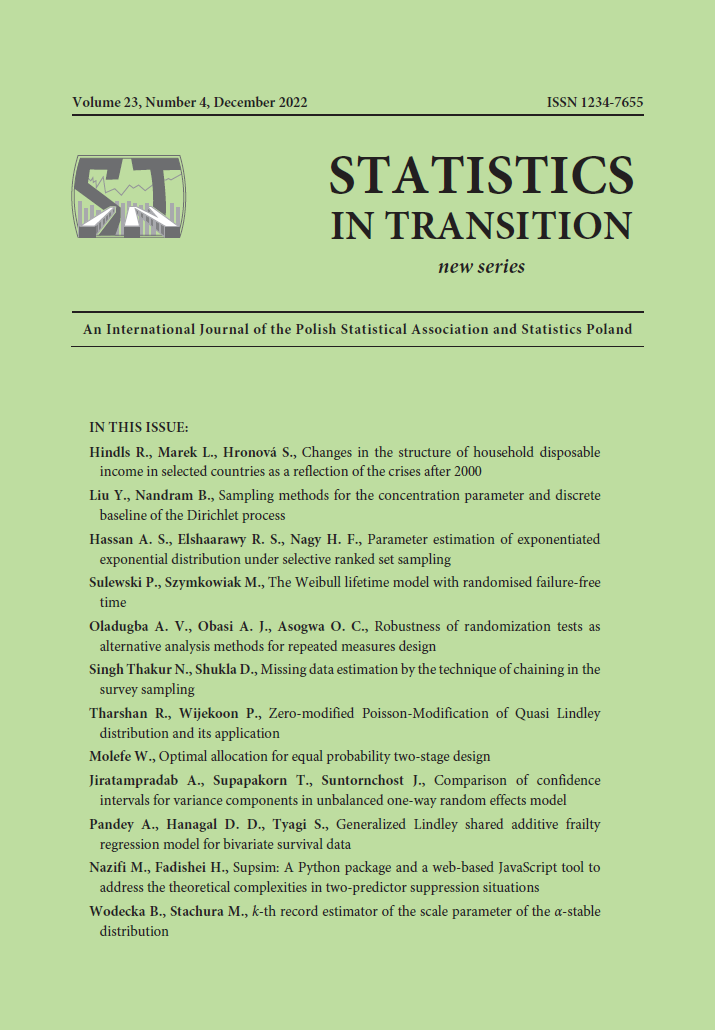ARTICLE
ABSTRACT
Two-predictor suppression situations continue to produce uninterpretable conditions in linear regression. In an attempt to address the theoretical complexities related to suppression situations, the current study introduces two different versions of a software called suppression simulator (Supsim): a) the command-line Python package, and b) the web-based JavaScript tool, both of which are able to simulate numerous random twopredictor models (RTMs). RTMs are randomly generated, normally distributed data vectors x1, x2, and y simulated in such a way that regressing y on both x1 and x2 results in the occurrence of numerous suppression and non-suppression situations. The web-based Supsim requires no coding skills and additionally, it provides users with 3D scatterplots of the simulated RTMs. This study shows that comparing 3D scatterplots of different suppression and non-suppression situations provides important new insights into the underlying mechanisms of two-predictor suppression situations. An important focus is on the comparison of 3D scatterplots of certain enhancement situations called Hamilton's extreme example with those of redundancy situations. Such a comparison suggests that the basic mathematical concepts of two-predictor suppression situations need to be reconsidered with regard to the important issue of the statistical control function.
KEYWORDS
Supsim, multicollinearity, suppression effects, statistical control function
REFERENCES
Alexander, d. L. J., Tropsha, A. & Winkler, D. A., (2015). Beware of R(2): Simple, unambiguous assessment of the prediction accuracy of QSAR and QSPR models. Journal of chemical information and modeling, 55, pp. 1316-1322.
Brown, N., (2005). Graphical illustration of two-predictor suppression effects, v0.05 [Online]. Available: https://steamtraen.shinyapps.io/suppressiongraphics/ [Accessed August 30 2020].
Cohen, J., Cohen, P., (1975). Applied multiple regression/correlation analysis for the behavioral sciences, Oxford, England, Lawrence Erlbaum.
Cohen, J., Cohen, P., (1983). Applied multiple regression/correlation analysis for the behavioral sciences, Hillsdale, N.J, Lawrence Erlbaum Associates.
Cohen, J., Cohen, P., West, S. & Aiken, L., (2003). Applied multiple regression/correlation analysis for the behavioral sciences, Mahwah, NJ, Lawrence Erlbaum Associates.
Conger, A. J., (1974). A revised definition for suppressor variables: A guide to their identification and interpretation. Educational and Psychological Measurement, 34, pp. 35 -46.
Conger, A. J., Jackson, D. N., (1972). Suppressor variables, prediction, and the interpretation of psychological relationships. Educational and Psychological Measurement, 32, pp. 579 -599.
Currie, I., Korabinski, A., (1984). Some comments on bivariate regression. Journal of the Royal Statistical Society: Series D (The Statistician), 33, pp. 283 -293.
Darlington, R. B., (1968). Multiple regression in psychological research and practice. Psychological Bulletin, 69, 161 -182.
Darlington, R. B., Hayes, A. F., (2017). Regression analysis and linear models: concepts, applications, and implementation, New York, The Guilford Press.
Fox, J., (1997). Applied regression analysis, linear models, and related methods, Thousand Oaks, CA, US, Sage Publications, Inc.
Friedman, L., Wall, M., (2005). Graphical views of suppression and multicollinearity in multiple linear regression. The American Statistician, 59, pp. 127 -136.
Hamilton, D., (1987). Sometimes R 2 > r 2 yx 1 + r 2 yx 2 : Correlated variables are not always redundant. The American Statistician, 41, pp. 129 -132.
Holling, H., (1983). Suppressor structures in the general linear model. Educational and Psychological Measurement, 43, pp. 1 -9.
Horst, P., (1941). The prediction of personal adjustment: A survey of logical problems and research techniques, with illustrative application to problems of vocational selection, school success, marriage, and crime, New York, NY, US, Social Science Research Council.
Kvalseth, T. O., (1985). Cautionary note about R2. The American Statistician, 39, pp. 279 -285.
Ludlow, L., Klein, K., (2014). Suppressor variables: The difference between ‘is’ versus ‘acting as’. Journal of Statistics Education, 22, null-null.
Lynn, H. S., (2003). Suppression and confounding in action. The American Statistician, 57, pp. 58 -61.
Mcfatter, R. M., (1979). The use of structural equation models in interpreting regression equations including suppressor and enhancer variables. Applied Psychological Measurement, 3, 123 -135.
Meehl, P. E., (1945). A simple algebraic development of Horst's suppressor variables. The American Journal of Psychology, 58, pp. 550 -554.
Mendershausen, H., (1939). Clearing variates in confluence analysis. Journal of the American Statistical Association, 34, pp. 93 -105.
Nazifi, M., Fadishei, H., (2021a). Supsim: A Python package simulating two-predictor suppression and non-suppression situations [Online]. Available: https://github.com/fadishei/supsim [Accessed 11 May 2021].
Nazifi, M., Fadishei, H., (2021b). Supsim: A Novel Computerized Algorithm Simulating Two-Predictor Suppression and Non-Suppression Situations [Online]. Available: https://youtu.be/6K82yDp-fNM [Accessed 10 November 2021].
Nazifi, M., Fadishei, H., (2021c). Supsim Project [Online]. Available: https://supsim.netlify.app/supsim [Accessed 11 May 2021].
Neill, J. J., (1973). Tests of the equality of two dependent correlations. Doctoral dissertation, University of California, Ann Arbor, Ann Arbor, MI: University Microfilms No.: 74 -7671.
Neter, J., Kutner, M., Nuchtsheim, C. & Wasserman, W., (1996). Applied linear statistical models (4th ed), Chicago, Irwin.
Pedhazur, E. (1997). Multiple regression in behavioral research: Explanation and prediction, Wadsworth, Thomson Learning.
Sharpe, N. R., Roberts, R. A., (1997). The relationship among sums of squares, correlation coefficients, and suppression. The American Statistician, 51, pp. 46-48.
Shieh, G., (2001). The inequality between the coefficient of determination and the sum of squared simple correlation coefficients. The American Statistician, 55, pp. 121-124.
Tzelgov, J., Henik, A., (1991). Suppression situations in psychological research: Definitions, implications, and applications. Psychological Bulletin, 109, pp. 524-536.
Velicer, W. F., (1978). Suppressor variables and the semipartial correlation coefficient. Educational and Psychological Measurement, 38, pp. 953-958.
Watson, D., Clark, L. A., Chmielewski, M. & Kotov, R., (2013). The value of suppressor effects in explicating the construct validity of symptom measures. Psychological Assessment, 25, pp. 929 -941.
Whuber, (2017). Generate a random variable with a defined correlation to an existing variable(s). Stack Exchange Inc.
